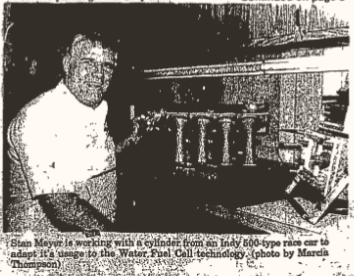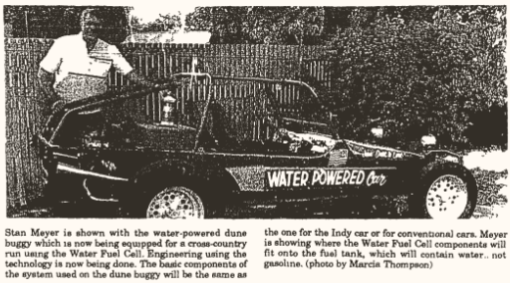Processing patents granted to Meyer - July 7th, 1988
By Marcia Thompson
July 7th, 1988
Source: https://grovecity.advantage-preservation.com/viewer/?k=&t=30203&i=t&d=01011901-12312011&m=between&ord=k1&fn=the_grove_city_record_usa_ohio_grove_city_19880707_english_1&df=11&dt=20
“What we’ve been waiting for so long has finally happened,” Stan Meyer of Grove City has announced. The U.S. Patent Office has completed the process of granting him all the patents on the Hydrogen Fracturing Process that triggers, sustains, and maintains hydrogen fusion at room temperature. The gas process simply prevents the formation of the water molecule during thermal gas ignition, releasing energy up to and beyond 160 million barrels of oil per gallon of water. No single man in history has, up to this point in time, ever held all the processing patents on the complete technology of a major invention like the Water Fuel Cell technology. "The ramifications are unbelievable," Meyer said.
Meyer is referring to his solution as the Water Fuel Injection System, and it applies to the growing energy source problem worldwide. His invention includes 42 processing patents, and the development covers several applications.
The 42 processing patents which Meyer has been receiving are different from design patents. The processing patents cover the methods of development, as well as the practical applications of the Water Fuel Cell system. The patents are linked together to give a broad range of ability to move into the economy in all areas, including retrofit systems (adapting the technology to existing car engines, for example).
The Patent Office moved with elimination problems, which could have led to technical blockages by foreign nations, said Meyer. "It was vital to legalize all the paperwork, work first to allow the technology to develop in many areas: aircraft, boat engines, other dry systems, and energy systems using hydrogen." The technology will allow the system to use areas in a myriad of ways, added Meyer.
“Especially in the last one and one-half months, we’ve been given preferential treatment at the Patent Office. It’s an unheard-of short amount of time to receive patent grants. They have over 200,000 patent applications backlogged, but they cleared all of ours in about eight months, so that indicates how vital they think this technology is,” Meyer explained.
Inventor uses water as fuel
 New energy source is vital
New energy source is vital
Nations all over the world are now recognizing that they must seek other energy sources than oil. Meyer named some reasons:
- The Department of Energy in the U.S. has been forced to admit to the American people that 60% of our oil must come from foreign countries to supply the demand in our country.
- Figures now indicate that oil pressure is dropping in oil fields—not only in the U.S. but worldwide—three times faster than expected.
- Russia expected to supply 40% of their energy needs from nuclear energy, but with the incident at Chernobyl, that program cannot be met.
- China has opened their doors to Western technology, and in China, 25% of the world population now wants more energy to supply their industrial base.
- Oil is no longer available on the spot market for the U.S. and Western countries.
"This is a tremendous problem facing us," says Meyer. "Figures show that if the foreign oil supply to the U.S. is shut off for as little as 27 days, we’ll face starvation. Our agricultural and industrial economy will come to an abrupt halt."
"The key now is that the process is done, and we now move into the legalization of the technology," said Meyer. "I want to see foreign governments be willing to sign agreements to apply to various sectors of the economy simultaneously."
Meyer continues to work on designing buildings for the Water Fuel Cell process. Much of the design of the project has been secured in Central Ohio. Now, it’s final patent processing, research, and development funding that is being sought through various sources.
Dune buggy demonstration
One of the first projects to demonstrate the use of the Water Fuel Cell system was the dune buggy Meyer first tested in October 1985. That car received worldwide coverage on ABC News syndication in many countries. Today, the dune buggy is being prepared for cross-country runs in Germany, where it will be running on Water Fuel Cell technology.
"The build of the system will use 90% of its materials derived from plastics," Meyer said. "The frame of the buggy is synthetic material. The dune buggy is lighter and will weigh far less than a normal vehicle. It will be used in an experimental capacity for more tests."
The same design circuits used in the system can also apply to large trucks and equipment, said Meyer.
Grove City inventor Stan Meyers is granted patent for innovative Water Fuel Cell
interest from backers. They want to be a part of history in the making."
Detractors have said that there might be an unfair advantage using the Water Fuel Cell in the Indy race—fewer pit stops, for example. Meyer says, "Not so. We’ll run the race under the same characteristics as the race is run today. The winner of the race will be determined not only by the car’s performance but also by the skill of the driver and an element of luck—just as it is today. Things occur—pin-outs, accidents, etc.—that just can’t be pre-judged, but we’ll ensure that we’ll be high-skilled competitors and give other racers a run for their money."
Several race car drivers have expressed interest in driving the car in the Indy 500 race, and Meyer estimates it will take about 20 people on the team to pull it all together.
"We’re in the continuous negotiation stage right now to bring this technology in on a worldwide basis," he says. "It will be a collective effort. The ice has been broken, and the research and technology stage is done. We’re going into the development stage."
Worldwide funding is sought
Meyer expects funding for further development to come from many areas which recognize the need for the system—countries from all over the world, military, and government, and industry. He says he will not incorporate to go for funding because of the danger of losing control of the technology.
"I’m still shocked at how fast things have moved," he says. "When the chips are down, the United States has said, 'He has a good idea. Let’s give him the ability to bring it home.' Now we have to go through fire and test it out. I feel that the government, in accord with people everywhere, will bring this system in as a viable answer to the energy problem."
Meyer says that would diffuse the Mid-East situation and probably avoid war. "It’s phenomenal to see different governments coming together to see this thing brought into being, and I just can’t help but feel that the money will be forthcoming to bring in the system. I’ll be honest—I’ve turned down money, because they want control of the tech base, and I won’t let that happen. I don’t want it to get into the wrong hands. Sometimes the greed in this world is disheartening. I’m continually amazed at efforts to prevent an alternate energy source from being brought into the economy."
"It will all come down to the people," he predicts. "If they want the system, it will happen. The United States may go through some hard times, but I feel that the people of our nation will get behind it and urge that it be brought in to solve the energy problem."

